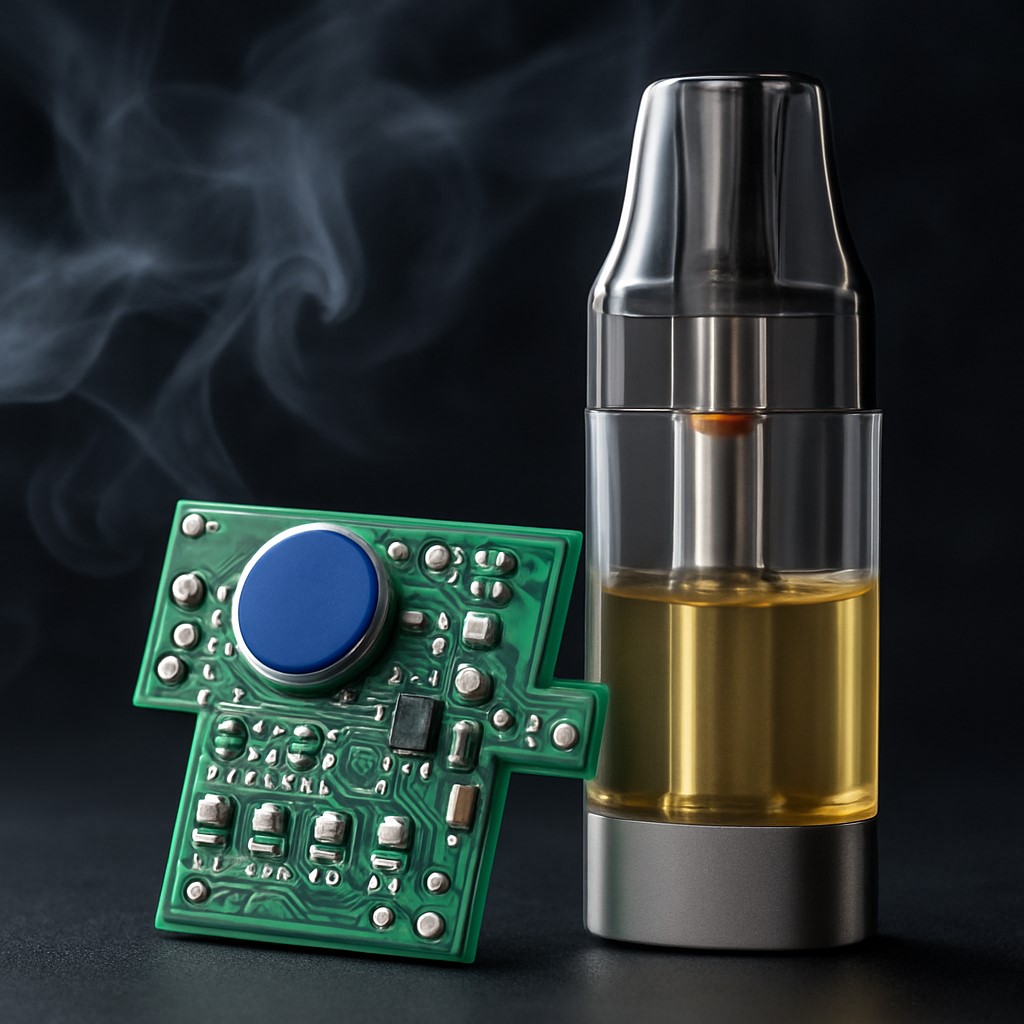Why PCB Design Matters in Flavored E-Cigarettes
As the global e-cigarette market evolves, flavored e-cigarette cartridges have emerged as a dominant consumer preference. Their sensory experience, vapor consistency, and safety depend heavily on precision electronics. At the heart of these systems lies the PCB (Printed Circuit Board)—the critical engine controlling performance, reliability, and user satisfaction.
In this article, we explore what makes a high-performance PCB for flavored e-cigarette cartridges. We discuss thermal management, power regulation, material selection, and integration capabilities. Ultimately, we aim to demonstrate how a well-designed PCB ensures stable heating, optimized flavor release, and regulatory compliance.
Section 1: The Role of PCBs in Flavor Cartridge Performance
A PCB in a flavored cartridge is not just a power delivery unit—it’s a micro-control center.
1.1 Stable Power Regulation
Flavored cartridges rely on stable voltage outputs to achieve uniform heating. Spikes in current can cause overheating, leading to flavor degradation or burnt residue. High-performance PCBs prevent these issues using:
-
Precision voltage regulators
-
Pulse Width Modulation (PWM) circuits
-
Real-time temperature feedback loops
1.2 Heating Element Synchronization
Flavors are sensitive to exact heating thresholds. A well-synchronized heating system enhances the sensory profile while preventing chemical breakdown. Advanced PCB features:
-
Thermistor integration for live feedback
-
Rapid response microcontrollers
-
Programmable temperature curves
1.3 Control Logic for Consistency
Each puff should deliver the same experience. That consistency requires embedded firmware logic to adjust output based on inhalation time, coil resistance, and battery status.
Section 2: Design Constraints in Flavored E-Cigarette Cartridge PCBs
2.1 Size and Shape Limitations
As cartridges get smaller, PCB design must adapt. The slim form factor limits layout space and thermal dissipation options. Engineers must:
-
Use multi-layer boards (often 4–6 layers)
-
Integrate flexible PCB sections for tighter spaces
-
Adopt embedded component placement to reduce profile
2.2 Thermal Bottlenecks
Flavored cartridges generate heat quickly. However, uneven thermal profiles result in localized burning or muted flavors. Heat sinks are rarely used, so PCBs require:
-
Copper-poured ground planes for heat spread
-
High-Tg (glass transition temperature) materials
-
Heat-tolerant solder masks and vias
2.3 Compliance and Safety Challenges
Global regulations demand strict thermal limits, leak prevention, and battery protections. A high-performance flavored e-cigarette PCB should include:
-
Short circuit and overcurrent protection
-
Automatic shutoff timers
-
UL- or CE-compliant components
Section 3: Materials Matter — Choosing the Right Substrate
PCB substrates greatly affect flavor delivery in vape systems. For flavored cartridges, the ideal materials must support thermal stability and signal integrity.
3.1 FR4 Limitations
Standard FR4 boards suffice for budget products, but often fail under continuous heat cycles. They may deform, delaminate, or cause inconsistent heating.
3.2 High-Tg FR4 or Polyimide
To optimize reliability, modern flavored vape designs use:
-
High-Tg FR4: Offers better thermal resistance
-
Polyimide boards: Provide excellent flexibility and durability
-
Ceramic-filled laminates: Enhance heat dissipation
3.3 Lead-Free and Halogen-Free Considerations
Eco-regulations now require halogen-free and RoHS-compliant PCBs. Manufacturers must ensure:
-
Solder paste compatibility
-
Component endurance under reflow soldering
-
No hazardous substances under normal vaping temperatures
Section 4: Firmware Integration and Sensor Feedback
A smart PCB adjusts to real-time usage, optimizing both flavor and safety.
4.1 Temperature Sensing and Control
Advanced PCBs use thermistors, RTDs, or infrared sensors to:
-
Detect rapid temperature changes
-
Avoid overheating
-
Trigger shutdown mechanisms
4.2 Inhale Detection Mechanisms
Flavored cartridges often include draw-activated triggers. These work through:
-
Differential pressure sensors
-
MEMS-based airflow detectors
-
Capacitive touch interfaces
4.3 Firmware Algorithms for User Profiles
Modern PCBs can store and learn from usage data. They adjust temperature profiles based on:
-
User preferences
-
Coil degradation
-
Ambient conditions
These features require onboard memory, real-time clocks, and efficient MCU usage.
Section 5: Manufacturing Challenges and Testing Protocols
Designing is only the first step. Manufacturing high-performance PCBs for flavored e-cigarettes requires:
5.1 Precision Assembly
Given the compact size, manufacturers use:
-
Laser-assisted soldering
-
Automated Optical Inspection (AOI)
-
X-ray validation for BGA components
5.2 Stress and Aging Tests
To validate long-term flavor performance, PCBs undergo:
-
1000+ cycle thermal shock tests
-
Humidity and corrosion testing
-
Electrical overstress simulation
Section 6: Toward Smarter, More Reliable Flavored Vape Devices
As competition intensifies, manufacturers must prioritize intelligent PCB design. By doing so, they ensure:
-
Richer flavor experience
-
Longer cartridge life
-
Safer thermal behavior
Additionally, integrated Bluetooth or app-sync capabilities may soon allow users to control flavor intensity or monitor usage metrics in real time.
Conclusion: PCB Innovation Drives Flavor and Trust
In the race to build more flavorful, safer, and compliant vaping solutions, the PCB for flavored e-cigarette cartridges sits at the core. It determines the heating behavior, ensures flavor fidelity, and safeguards user health.
At RIMYI, our PCB solutions for e-cigarette cartridges are tailored to address these technical challenges. We design with thermal resilience, firmware intelligence, and miniaturization at the forefront. As vaping products continue to evolve, our commitment to precision PCB engineering ensures every puff delivers not just vapor, but reliability, flavor, and trust.

